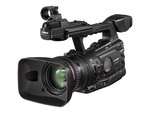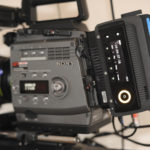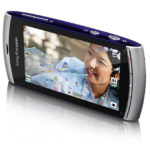
REVIEW – Canon XF305e Camcorder
Posted on May 25, 2010 by Alex Fice
ADAM GARSTONE reviews the latest camcorder from Canon, even though it didn’t have a full frame sensor he was impressedUnusually, I’m going to start with the faults of Canon’s new, tapeless, professional HD camcorder, the XF305.
Let me see. Er… it’s a bit heavy. It’s a bit expensive. I suppose if I was being really critical, some of the plastics used are, well, a bit plasticky.
That’s it. I can’t think of any more. In every other way the XF305 is as divine a camcorder as you’ll find in this class. It has a brother, the XF300, which is basically the same but lacks some of the ‘studio’ functions; genlock, timecode and HD-SDI BNCs (so when I mention the XF305 in the review, you can assume the XF300 is identical).
The list of good things about these heavenly twins starts with Canon’s decision on the recording format. At the highest quality settings, they compress full 1080p/i HD using 4:2:2 MPEG-2 at 50Mbits/s and store the resulting MXF files on nice, freely available, relatively cheap Compact Flash cards. Yah, boo, sucks to those manufacturers who charge outrageous amounts for their proprietary cards. There are a variety of lesser formats to give you longer recording time on a card and, if you drop to 720p, you can record at up to 50fps. A 32GByte card should give you about 80 minutes at 50Mbits/s and there are two card slots so you can hot-swap between them. There is also an SD card slot, for storing user settings.
The XF305 uses three, one third inch, full 1920×1080 CMOS sensors, which have an optimised, fast readout to minimise the ‘rolling shutter’ problems normally associated with CMOS. In front of the sensors is an 18x zoom lens sporting Canon’s coveted ‘L’ rating – that’s the red ring you see on their top-of-the-line professional lenses which use Ultra Low Dispersion grass with aspherical elephants, or something like that. At its widest zoom, the lens focal length is 4.1mm, which is the equivalent of about 29mm on a 35mm still frame. Maximum aperture ranges from f/1.6 to f/2.8.
This lens is the second truly stand-out feature of the XF305. I’ll deal with image quality later, but Canon stress the degree to which they asked broadcasters and cinematographers for input on the design of this camera, and the lens handling is where this is most obvious. The focus ring can be used as a true, manual control with a calibrated scale and end stops. However, if you press a button and turn the lens barrel behind the focussing ring, the calibrated scale disappears and the focussing ring becomes an ‘endless encoder’, with both manual and auto-focus. I really love this feature. Talking of auto-focus, the XF305 features Canon’s amazing, wonderful and unique auto-focus assist sensor. The camera electronics focus using a combination of the data from the image sensors and this dedicated, external sensor, for an auto-focus response faster and more accurate than any of their competitors. Once you have seen how Canon camcorders snap into focus you won’t want to use anything else in run-and-gun videography. The zoom ring is also a calibrated control with end stops, though the iris is an endless encoder. Sadly, the zoom ring isn’t powered – if you switch to using the power-zoom rocker the zoom ring is disconnected.
The attention to detail in the handling of the camera isn’t limited to the lens controls. There are plenty of dedicated buttons for zebra, peaking, image stabilisation and so on – all well placed and logical, with none of the fiddliness that mars Sony’s HXR-NX5. The menu thumbwheel doesn’t have a ‘press to select’ function – you have to hit the Set button next to it – but I would rather that than the NX5’s overly sensitive click that had me selecting random, unwanted menu items. If you want a single control, there is a joystick on the handle that can be used for both menu navigation and selection. The menus themselves are straightforward.
All of which brings me to the next outstanding feature of the new Canon – the LCD. It is, quite simply, gorgeous – a four inch diagonal, 1.23M dots, a true 100% view and an interesting mount that allows it to be used on both the left and right hand side of the camera – it lives under the transport controls on the handle when stowed. The size and high resolution somehow reminds me of using a film camera with a ground glass screen – with the added benefit of ‘peaking’ focus assist (two selectable settings, each with programmable colour, gain and frequency), magnification and a very comprehensive waveform monitor and vectorscope inlay (as well as the usual suspects of camcorder on-screen data). Like most large LCDs it can be tricky to see in bright sunlight, so you might want to invest in a shade, or simply switch to using the excellent EVF.
Image Quality
The ‘L’ spec lens on the XF305 is excellent. There is no hint of chromatic aberration, though there is some barrel distortion at the widest setting. Out of focus areas are rendered well and contrast is maintained well in flaring lighting conditions. The lens and sensor system are specified to resolve “1000 TV lines or more (1920x1080i mode)” – my review sample managed well over that, even at the frame edges with the lens wide open. Noise is well controlled given the small sensor size, and colour reproduction is excellent with smooth tonality and an excellent dynamic range. Digital image control includes the usual cine style gammas and colour mapping (you can programme custom configurations) all of which adds up to the ability to shoot stunning images with the XF305. The small sensor inevitably loses out in sensitivity to cameras with more silicon to catch the photons, but otherwise the XF305 has replaced Sony’s EX1 at the top of my nattily named “Best Pictures from a Fixed Lens Camcorder List”.
Sound is recorded in 16 bit linear PCM – there are two XLRs with phantom power and limiters as well as the built-in, handle mounted stereo mic. These mics and the LCD mount protrude well forward of the lens – you might need to take this into consideration if you want to add a third party matte box.
People panic over tapeless workflows, but Canon have provided a plug-in for Log and Transfer in Final Cut Pro, as well as the other mainstream NLEs (Avid, Adobe Premiere and GV). The camera has a USB interface or, being an ‘open’ standard card format, you can use a cheap external card reader. In FCP the plug-in defaults to transcoding the MPEG 2 into standard ProRes, but you can select any of the other ProRes options or import the footage natively. It couldn’t be easier.
Conclusion
The XF305 is currently pre-ordering in the shops at about £6200 plus VAT (the XF300 is cheaper at £5500 plus VAT). That’s a lot of money, though it should come down as the product matures. Nevertheless, if you have the budget, you simply won’t get a camera in this form factor that is easier to use or shoots better pictures.













